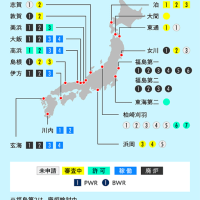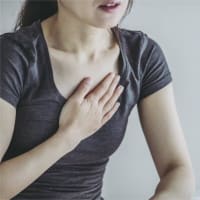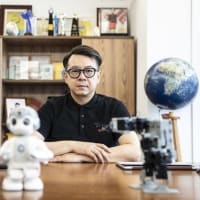2015-03-02 16:25:22 mugendai-web.jp
Hybrid high speed makes them multiply an alga of 2 kinds of--by which an alga makes Japan a petroleum-producing nation,
and the day when energy independence will be done comes.
2013.11.14 | bioenergy
The energy self-sufficiency rate of Japan is only 4 %. It's the lowest standard at a main advanced. The nuclear power generation called the associate domestic energy isn't also working mostly after an accident of Tokyo Electric Power Daiichi Fukushima nuclear power plant in March, 2011. Will you also keep depending on a condition of the energy poor country and import from foreign countries for Japan now? An answer like such dream was announced several years ago to this question.
"A study of the renewable energy resources which may change Japan to a petroleum-producing nation in the future is developed."
Its wealth which was in hot public attention is domestic and abroad and the "alga" into which I grow in the water. 2 kinds of alga with the full procreative power is combined, and, hybrid, I make them multiply and petroleum alternative energy is picked out high-efficiently. It's after that, of development of research and development and future, you look through and what happens to a problem? I was a leader of a Japanese alga study and visited at a laboratory of the University of Tsukuba life environment which is a leader of a project and Prof. Makoto Watanabe.
Energy problems are solved by an alga.
After Fukushima's nuclear accident, a national expectation to renewable energy is rising increasingly. The spread of photovoltaic generation is developed and a demonstration experiment of effective on the ocean wind power generation has also started.
But those renewable energy premised on consumption as the electric power. End form of the energy isn't only the electric power. When a source of heat of town gas and natural gas, transit fuel and plastics also include the various chemicals which make the petroleum a raw material, the general energy consumption of Japan consists of 4 times of the consumption as the electric power. Even if it's seen in case of transit fuel, development of an electric car would be accelerated from now on, but it's difficult even to move an airplane and shipping by electricity as expected.
That Tanaka is taken up in recent years as petroleum alternative energy meets and is "alga".
It was also filled in 1 millimeter in the alga according to Prof. Makoto Watanabe of University of Tsukuba life environment, I say to the small body I don't have that there is something Tsutomu who produces alternate fuel of petroleum efficiently has.
The energy amount you can produce per the unit area will be also hundreds of times of the corn of the same biofuel. Moreover fuel use of corn is a worldwide problem in recent years because I get in touch with soaring of the cereal price and take the cultivation area of the crop away but such worry isn't because the alga is irrelevant mostly in edibility.
The leading role is Botryococcus and Aurantiochytrium.
An alga of 2, Botryococcus and Aurantiochytrium will be the leading role by the large-scale alga energy production plan Prof. Watanabe proposes.
Botryococcus receives light in the sun, does photosynthesis and produces biofuel near petroleum as "hydrocarbon".
Prof. Watanabe aims at Botryococcus for a long time as an alga researcher, and Minami collects an alga as much as 200 kinds all Japan to Okinawa from Hokkaido, and Kita has narrowed one which suits fuel production most down.
But there are regional odds to bring up Botryococcus which multiplies by photosynthesis by Japan and get a great deal of hydrocarbons. "For the hours of sunshine of Japan, half of the suitable land where Southeast Asia and Nishibe of Australia are foreign countries short? For 8 months, there is also less than an average of 15 ℃ of month for 4 months at Kyushu at the northeast the temperature. That's big odds.".
So Prof. Watanabe tries to have another new alga play an active part.
That's Aurantiochytrium where Prof. Watanabe finds it by Okinawa and is also called "alga of a dream" already in 2009. The inside which is less than 1 % and Aurantiochytrium also make a hydrocarbon for 20% for the hydrocarbon many algae make per the dry weight.
Multiplication is also remarkably fast. While BotryococcusBOTORIOKOKKASU multiplies double in about 6 days, Aurantiochytrium becomes double in only 4 hours. Oil production efficiency will be also 12 times of Botryococcus.
"The heterotrophic nutrition which makes the organic matter "food" and multiplies even if there is no light in Aurantiochytrium, it's an alga. It's always necessary to feed, but photosynthesis isn't needed, so it's possible to cultivate for 24 hours in the tank. Short, the hours of sunshine are an alga ideal for Japan in a small country."
Prof. Watanabe who expects it of a possibility that Aurantiochytrium has it adds the oil refined from this alga to light oil 70 % by a common experiment with Mazda in 2011, a diesel engine car, dispatch it's successful. Mixing rate even was a heroic achievement at the inside where I'm aiming at 50% USA running through a tip of the world for practical use. I say that 100% won't be also a dream in the future.
The efficiency is raised thoroughly by a hybrid system.
Does the cost how to do invent the energy be reduced and it be made an unwasted efficient system?
So the alga by which the plan Prof. Watanabe proposed is 2 kinds, these Botryococcus and Aurantiochytrium, it's compound, the hybrid system to utilize. The drastic yellowtail which complements the mutual strong point and trouble each other is wonderful.
Organic matter is included in human home wastewater richly. The first treated sewage which processed the organic wastewater is made "feed" of Aurantiochytrium. If a waste fluid of sewage mud and a food factory is waste including organic matter, I say that most will be feed of Aurantiochytrium. First, it's possible to get a hydrocarbon from Aurantiochytrium with this.
Next nitrogen in the home wastewater and phosphorus are left for secondary effluent ahead of it, so I utilize this for cultivation of Botryococcus outdoors this time and get a hydrocarbon again here. The planktonic abnormal outbreak which occurs because of nitrogen and phosphorus with this can also be stopped.
After getting a hydrocarbon from each of Aurantiochytrium and Botryococcus, the residual which can be done is used for feed of cattle and the material for methane fermentation. Or it's made more soluble and it's used as feed of Aurantiochytrium.
A residual will be burned at this time, but the carbon dioxide which comes out is utilized for photosynthesis of Botryococcus, and heat is also utilized to heat up a tank of Aurantiochytrium .
The demonstration experiment to which the part of this system that Prof. Watanabe and others plan was introduced is performed already in country. A demonstration experiment for establishment of outdoor large-scale culture technology of an alga is advanced from fiscal year 2012 as a try of "Tsukuba international strategy overall specific district" in Tsukuba-shi where University of Tsukuba is here.
University of Tsukuba and Tohoku University are an association in Sendai-shi from May, 2013 at the south Gamo purge center of Sendai-shi near Prof. Watanabe's home and Miyagi-ken Marumori-machi, and the "alga biomass demonstration experiment" to get a hydrocarbon from Aurantiochytriu has started.
When doing profit utilization of this hybrid system by an abandoning cultivation place and multiplying an alga, Japan will also become possible of the theory top to become a petroleum-producing nation in the future. When there is size of the Japanese only 5 % in a fallow field and 1/3 of Biwa-ko Lake when it's supposed that there is abundance of the organic matter and the resources which become nutrition of an alga for nitrogen and phosphorus enough, I say that it's possible to serve Japanese annual energy import volume.
And the big merit of this alga bioenergy is petroleum alternative energy above all, so petroleum infrastructure of existence is to be able to use just as it is. Plastics doesn't have to make a hydrogen station intentionally and can also produce a petroleum product of course.
2015-03-02 16:25:22 mugendai-web.jp
藻類が日本を産油国にする――2種の藻をハイブリッド高速増殖させ、エネルギー自給ができる日がやってくる
2013.11.14 | bioenergy
日本のエネルギー自給率はわずか4%。主要先進国で最も低い水準だ。準国産エネルギーといわれてきた原子力発電も、2011年3月の東京電力福島第一原子力発電所の事故以降ほぼ稼働していない。日本はこれからもエネルギー貧国のまま、海外からの輸入に頼り続けるのだろうか。この問いに対して、数年前にこんな夢のような答が発表された。
「将来、日本を産油国に変えるかもしれない再生可能エネルギー資源の研究が進んでいる」
国内外で熱い注目を浴びたその資源とは、水中で生育する“藻類”だ。旺盛な繁殖力をもつ2種の藻を組み合わせてハイブリッド増殖させ、石油代替エネルギーを高効率に抽出する。その後の研究開発の進展や今後の見通し、課題はどうなっているのだろうか。日本の藻類研究の第一人者であり、プロジェクトのリーダーである筑波大学生命環境系・渡邉信教授の研究室を訪ねた。
藻類でエネルギー問題を解決
福島の原発事故以降、再生可能エネルギーへの国民の期待がますます高まっている。太陽光発電の普及が進み、効果的な洋上風力発電の実証実験も始まった。
しかし、それらの再生可能エネルギーは電力としての消費を前提としたものだ。エネルギーの最終形態は電力だけではない。都市ガスや天然ガスなどの熱源、運輸燃料、それにプラスチックなど石油を原料とするさまざまな化学製品も含めれば、日本の総エネルギー消費量は電力としての消費量の4倍以上にもなる。運輸燃料の場合をみても、電気自動車の開発は今後加速するだろうが、やはり飛行機や船舶まで電気で動かすのは難しい。
そうしたなか、石油代替エネルギーとして近年クローズアップされているのが“藻類”である。
筑波大学生命環境系の渡邉信教授によると、藻類の中には1ミリにも満たない小さな体に、石油の代替燃料を効率よく生み出す力が備わっているものがあるという。
単位面積あたりで生産できるエネルギー量は、同じバイオ燃料のトウモロコシの数百倍にもなる。しかも、トウモロコシの燃料利用は穀物価格の高騰につながったり作物の耕作面積を奪うため、近年世界的な問題になっているが、藻類は食用にはほぼ無縁のためそうした心配がない。
主役はボトリオコッカスとオーランチオキトリウム
渡邉教授が打ち出している大規模な藻類エネルギー生産構想では、ボトリオコッカスとオーランチオキトリウムという2つの藻類が主役となる。
ボトリオコッカスは太陽の光を受けて光合成をし、“炭化水素”という石油に近いバイオ燃料を生み出す。
藻類研究者として渡邉教授は長年ボトリオコッカスに着目し、北は北海道から南は沖縄まで日本中で200種類もの藻を採集して燃料生産に最も適するものを絞り込んできた。
しかし、光合成で増殖するボトリオコッカスを日本で育てて大量の炭化水素を得るには地域的ハンデがある。「日本の日照時間は短く、東南アジアやオーストラリア西部など海外の適地の半分ほど。気温も、平均15℃以下の月が東北では8ヵ月、九州でも4ヵ月もあります。それが大きなハンデとなっています」。
そこで、渡邉教授は、もうひとつの新しい藻類に活躍してもらおうとしている。
それこそが2009年に渡邉教授が沖縄で発見し、今や“夢の藻”とも称されているオーランチオキトリウムだ。多くの藻類が乾燥重量あたりつくる炭化水素は1%未満であるなか、オーランチオキトリウムは炭化水素を20%もつくる。
増殖のスピードも格段に速い。ボトリオコッカスが約6日で2倍に増殖するのに対し、オーランチオキトリウムは、わずか4時間で2倍になる。オイル生産効率はボトリオコッカスの12倍にもなる。
「オーランチオキトリウムは、光がなくても有機物を“餌”にして増殖する従属栄養性藻類です。餌を常に与える必要がありますが、光合成を必要としないので、タンクの中で24時間培養することができます。日照時間が短く、狭い国土の日本にうってつけの藻類です」
オーランチオキトリウムのもつ可能性に期待する渡邉教授は2011年、マツダとの共同実験で、この藻類から精製した油を軽油に70%混ぜ、ディーゼル車を走らせることにも成功している。実用化に向けて世界の最先端を走っている米国でさえ、混合率は50%を目指している中での快挙であった。将来は100%も夢ではないという。

ハイブリッド・システムで効率性を徹底的に高める
いかにエネルギーを生み出すためのコストを減らし、無駄のない効率的なシステムにするか。
そこで渡邉教授が打ち出した構想が、このボトリオコッカスとオーランチオキトリウムの2種類の藻類を複合的に活用するハイブリッド・システムだ。互いの長所と短所を補完し合う、その徹底ぶりがすごい。
人間の生活廃水には有機物が豊富に含まれる。その有機廃水を処理した一次処理水をオーランチオキトリウムの“餌”とする。下水汚泥や食品工場の廃液など有機物を含む廃棄物なら、ほとんどオーランチオキトリウムの餌になるという。これでまず、オーランチオキトリウムから炭化水素を得ることができる。
次に、その先の二次処理水には生活廃水中の窒素やリンなどが残されるので、今度はこれを屋外でボトリオコッカスの培養に活用し、ここでまた炭化水素を得る。これで窒素やリンが原因で起きるプランクトンの異常発生も防げる。
さらに、オーランチオキトリウムとボトリオコッカスそれぞれから炭化水素を得たあとにできる残渣を、家畜の飼料やメタン発酵のための材料に利用。あるいは可溶化してオーランチオキトリウムの餌として利用する。
このとき残渣を燃やすことになるが、出てくる二酸化炭素をボトリオコッカスの光合成に活用し、熱もオーランチオキトリウムのタンクを温めるのに活用する。

渡邉教授らが構想するこのシステムの一部を取り入れた実証実験は、国内ですでに行われている。筑波大学のあるつくば市では「つくば国際戦略総合特区」の試みとして、2012年度より、藻類の屋外大量培養技術の確立に向けた実証実験が進められている。
また、渡邉教授の故郷、宮城県丸森町に近い仙台市の南蒲生浄化センターでは、2013年5月から筑波大学、東北大学、仙台市の共同で、オーランチオキトリウムから炭化水素を得るための「藻類バイオマス実証実験」が始まった。
このハイブリッド・システムを耕作放棄地などで利活用して藻を増殖すれば、将来日本が産油国となることも理論上は可能となる。有機物や窒素・リン等藻類の栄養となる資源の賦存量が十分あると仮定すると、日本の休耕田のわずか5%、琵琶湖の3分の1の広さがあれば、日本の年間エネルギー輸入量を賄うことができるという。
そして何よりこの藻類バイオエネルギーの大きなメリットは、石油代替エネルギーであるので、既存の石油インフラがそのまま使用できることだ。水素ステーションなどをわざわざ造らなくてすむし、プラスチックなど石油製品ももちろん生産できる。




















※コメント投稿者のブログIDはブログ作成者のみに通知されます